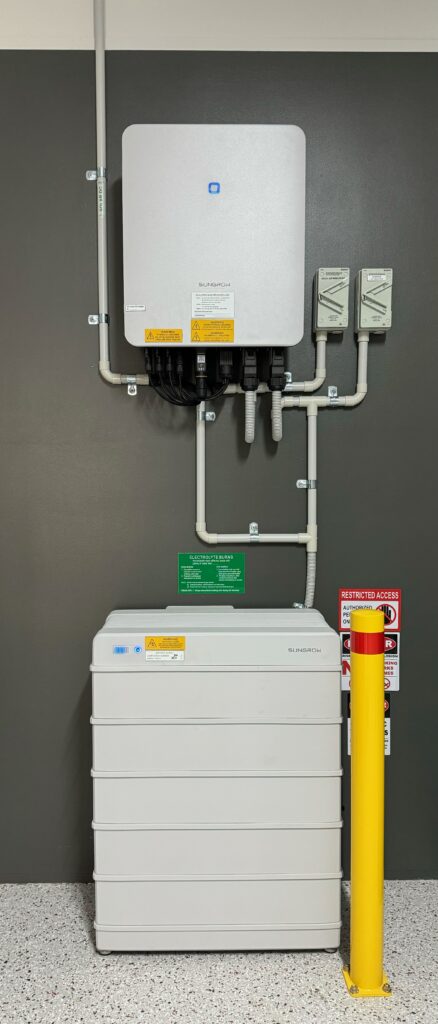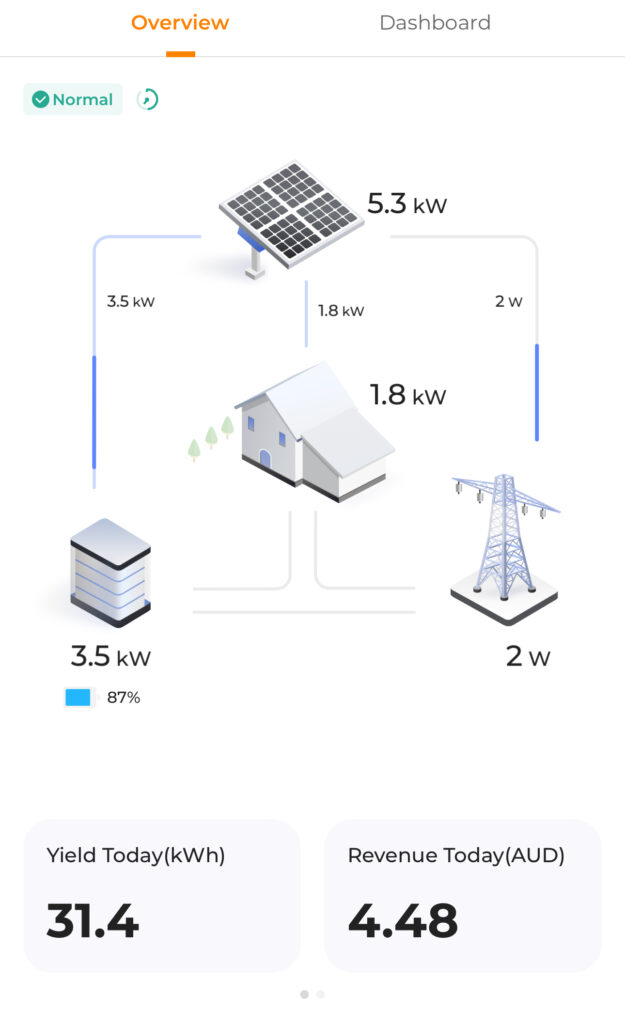In my first job at BHP Information Technology in Newcastle — back in the 1990s, there was a running joke that if you needed to urgently talk to the most senior manager in the building, all you had to do was leave a light on in an empty room and walk away for a few minutes. He was a great leader (I regret these days I was so junior and nervous that I could never bring myself to have anything but the most perfunctory conversation with him), but he was also passionate about conserving power usage. So naturally since he’d get up and walk around between meetings to stay mobile (another lesson it took me years to learn), he’d quickly find lit, unoccupied rooms and deal with them accordingly.
I say all this because having recently taken the plunge to get solar on for our new house, I find myself sometimes obsessing about what is still on and powered up. Sometimes. (As long as it’s not computer related.)
Our house seems well suited, placement and design-wise for solar. The house is North/South facing and much longer than it is wide. Which means there’s plenty of roof space on the east/west sides of the house for solar panels. Or rather, there was. 34 solar panels later and there’s a lot less space on the east/west sides of the house for solar panels.
Our power usage isn’t small — I admit, I have a lot of gadgets that like a flow of power. (4 x Synology NAS systems, 2 x PowerEdge R730xd servers, a bunch of workstations and computers and whatnot all have a not insubstantial draw). So solar to us isn’t just about saving money (and it’s questionable how long it takes to actually start saving money), but it’s an ethical investment in reducing the amount we have to draw down from the grid, especially when the grid in Australia still has a higher than desirable percentage of fossil-fuel power.
And because it was within our budget, it’s not just about solar, but battery systems as well. (Ironically, as soon as you say “house battery”, people assume Tesla, but it will be a cold day in hell before Mr Musk gets even the smallest cent knowingly from my bank account. Instead, our system comes from a company called Sungrow.)
The system we went for comprised of 14.96 kW in solar panels, a 10 kW inverter, and a 16 kW inline battery system; it seemed pointless to install a battery system for the solution without making sure it was inline, with auto-switchover, rather than the conventional (and yes cheaper) approach of requiring manual switchover in event of grid failure. For those interested in cost, it was a substantial investment — even with the federal government rebate, the total equipment plus install pulled just under $27,000 out of the bank.
Solar wasn’t included in our house package, so it was all something we had to organise post-handover. Thankfully, the home company’s sales representative we dealt with knew enough to suggest that we install 3-phase power from the start if we were going to be adding solar, which apparently has some advantages. (The solar folk agreed with this strategy. They were able to quote electricity-related facts to me about it, but like my electrical & computer engineering days at university, such facts flew straight over my head at a speed that almost broke the sound barrier.)
Solar takes room — especially if you’re going with a battery backup as well. So we had to reserve part of our garage for the inverter and battery. Safety standards require an additional layer of concrete sheeting behind the battery, and a bollard to shield the battery from vehicles using the garage too, so our setup inside the house ended up resembling the following:

Installation was … chaotic. The concrete sheeting was installed first, and we were given a couple of days then before the solar installation took place; that let us (and by “us”, I mean my husband) source a plasterer and a painter on the local Facebook community group who could come around and tidy up the sheeting. Which, I have to say, was well worth it — both my husband and I have a number of talents but plastering and painting do not appear in that list. (Ironically, the cleanup work was done so well that the solar company needed to take photos of the completed setup to use in their promotional material.)
Panel installation took an entire day; a two-person crew worked from 8am to midday or thereabouts to install the safety scaffolding and get the initial rails installed, and that expanded to a four-person crew after lunch — three on the roof installing the panels, and a sparkie dedicated to the inverter/battery installation in the garage. By the time that was done, there wasn’t enough time left in the day to complete the integration into the house power, so that was to be done later. We had an anticipatory power outage from about 3pm thinking the connection was going to happen that day, but by it turned out to be premature.
When they came back for the power integration it was … a bit of a nightmare. What was meant to be a one-hour power outage at 1pm extended to 6 hours — while the builder had definitely installed three-phase power for us as purchased, they also skimped on the meter box, making the connectivity considerably problematic for the solar team. They ended up having to install a second meter box and rerouting the majority of the circuits and breakers across from the primary to the secondary to have room to install all the switches for the inverter and battery.
But getting the power integrated is just part of the work. Before we could be switched over to actually running the system, we needed an electrical safety inspector to come by to review the work and certify it was safe to do so. And so began a 5-day wait for that to take place. That led to another power outage while the inspection took place (roof, meter and battery/inverter) before we were at last told it was OK to proceed and the various switches were flipped. (If you’re wondering what power deal we’ve reached with our energy provider, we haven’t — they apparently take up to 40 business days to contact us to discuss, and they seem keen to take all that time before getting in touch.)
Now, it turns out just because everything worked fine on regular power it’s not guaranteed that it’ll all work once you have solar integrated. So, when the weekend arrived after a few days of successful solar operations, we learned that the hard way with some fairly intense power outages. It turned out the regular power distribution in the house was tolerant of our 18-year-old Miele dryer running at the same time as the washing machine and anything in the kitchen (including a boiling kettle), but with solar integrated, the system would throw the toys out of the cot and shutdown power to the house. That ‘exciting’ day saw my second lab server taken out. (The first had already screamed itself to death a few weeks earlier from age and possibly the stress of the move.) Thankfully the only thing we lost during the multiple outages — but that’s why I’ve now got 2 x R730xd’s running my home lab.
The net result though is this:

As I type this, it’s an incredibly beautiful sunny day in Ballarat. Chilly too (9.9 degrees Celsius/feels like 4.3), but solar doesn’t really care about how cold it is so long as there are rays coming down. (Good thing, too. Ballarat is definitely colder than Melbourne — joyously.)
On a good day when we get to 100%* charge on the battery before sunset, we run the house sans-grid until close to midnight; overall our estimation is that on a good day we use around a third of the grid power that we previously did — and that’s not accounting for overflow that goes back into the grid. We can still add another two packs to our battery stack before we’d have to expand out to another stack, and I can see us adding them within the year.
Yes, there’s cost in the setup, and if you were doing it to “make money”, you’d be about as financially savvy as someone buying into NFT scams. Ethically though, it’s a no-brainer. Every watt of power we generate from renewable sources is a win for the environment; when we rented that wasn’t really an option, tied to whatever was setup at the property we were living in — in our own house, it was seriously the first priority once we’d moved in. In short, if you can, you ought to — fully recognising that not everyone can.
Now, that 100% asterisk from earlier — now everything is setup and working, I can focus on first-world-problems, and that’s the UX of the solar power dashboard, like you see in the example screen shot above. It’s only a minor thing, but in terms of the user satisfaction, I think it’s an annoyingly obvious one. It never gets to 100%. Because the battery has to divert power to the grid at that point, you technically never reach 100% charge as far as the display is concerned. And that’s actually surprisingly unsatisfying. A little rounding up wouldn’t go astray there. But that said, if that’s my primary complaint with the setup we’ve ended up with, it’s one I can live with.
And hopefully the environment can, too.
Total aside: I’m currently obsessing over this song and can’t recommend it enough. (The entire album by KSHMR is one of the most nuanced, best albums I’ve heard in my life.)
Before you go — I’m running a book giveaway. Why don’t you enter it?
[CP_POLLS id=”12″]
